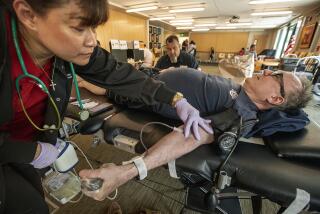BLOOD DOPING: HOW IT’S DONE : FUELING THE RACING MECHANISM
- Share via
On Jan. 10, 1985, four U.S. Olympic Committee doctors, following a two-month investigation, confirmed that a third of the 24-member U.S. Olympic cycling team--including five medal winners--received blood doping transfusions before their events in the ’84 Games. At the time, the practice of blood doping (also referred to as blood packing or blood boosting) was not illegal by International Olympic Committee or U.S. Cycling Federation rules, though condemned by the IOC and United States Olympic Committee. Blood doping has since been banned by the IOC, though there are no means of testing for it. Here’s an explanation of the blood-doping technique:
1. Months before competition, a pint of blood is taken from the athlete’s body.
2. The blood is gently “spun down” to separate serum from red blood cells. Red blood cells comprise approximately 44% of blood volume.
3. About a month later, when the athlete’s blood count has risen to normal, another unit of blood is removed, spun down and
kept in a cold liquid state.
4. The athlete resumes training while the blood concentrate is refrigerated, 80 degrees Celsius.
5. About a week before his event, the two concentrated units of blood are dripped back into his system, thereby raising his red cell count. The transfusion may also be of blood from another person of the same blood type.
Physical fatigue occurs when the demand for oxygen (O2) by the muscles exceeds the capacity of the oxygen transporting red blood cells to replenish oxygen reserves. The muscles basically “run out of gas,” causing a drop in performance to alevel directly propoetionate to the body’s ability to supply fresh oxygen.
The blood-doping technique is designed toe aid endurance by increasing the number of red blood cells above the “norman” level, thus making more working cells available during periods of high stress. The quantity of oxygen (fuel) delivered to the muscles increases proportionately, thus delaying the threshold of physical fatigue.
Red blood cells, pumped by the heart, carry the oxygen to the various organs.
During periods of physical exertion the muscles become the primary users of oxygen and many other bodily function, such as digestion, continue at a much reduced rate.
SUPPLEMENTAL BLOOD CELLS The introduction of additional red blood cells temporarily increases the volume of oxygen that may be circulated to the organs.
More to Read
Go beyond the scoreboard
Get the latest on L.A.'s teams in the daily Sports Report newsletter.
You may occasionally receive promotional content from the Los Angeles Times.






